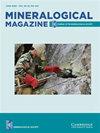The position of vanadium in the crystal structure of zoisite, variety tanzanite: Structural refinement, optical absorption spectroscopy and bond-valence calculations
IF 1.4
3区 地球科学
Q2 MINERALOGY
引用次数: 0
Abstract
Abstract Vanadium is the dominant trace element and chromophore in tanzanite, the most valued gemmological variety of zoisite. The structure of zoisite–tanzanite was obtained by structural refinement to assess the vanadium location in the zoisite structure. However, the small V content in tanzanite evidenced by electron microprobe and laser ablation inductively coupled plasma mass spectrometry limits the exact determination of the V position in the zoisite structure. Structural refinement revealed that the average bond length of the less distorted M1,2O6 octahedron is below 1.90 Å, and M3O6 has slightly longer bonds with an average of ca. 1.96 Å. The M1,2 site is slightly overbonded with a bond-valence sum (BVS) of 3.03 vu, whereas M3 is slightly underbonded (BVS = 2.78 vu). Optical absorption spectra revealed that most V is trivalent, but a small portion is probably in a four-valent state. Therefore, crystal field Superposition Model and Bond-Valence Model calculations were applied based on several necessary assumptions: (1) V occupies octahedral sites; and (2) it can occur in two oxidation states, V3+ or V4+. Crystal field Superposition Model calculations from the optical spectra indicated that V3+ prefers occupying the M1,2 site; the preference of V4+ from the present data was impossible to determine. Bond-Valence Model calculations revealed no unambiguous preference for V3+, although simple bond-length calculation suggests the preference of the M3 site. However, it is quite straightforward that the M1,2 site is better suitable for V4+. If the possible octahedral distortion is considered, the M1,2O6 octahedron is subject to a smaller change in distortion if occupied by V3+ than the M3O6 octahedron. Consequently, considering the results of both the crystal field Superposition Model and Bond-Valence Model calculations, we assume that both V3+ and V4+ prefer the M1,2 site.钒在黝帘石晶体结构中的位置,坦桑石品种:结构细化,光学吸收光谱和键价计算
摘要钒是坦桑石中主要的微量元素和发色团,坦桑石是黝帘石中最具价值的宝石品种。通过结构精化,得到了黝帘石-坦桑石的结构,评价了钒在黝帘石结构中的位置。然而,电子探针和激光烧蚀电感耦合等离子体质谱法证明坦桑石中V含量低,限制了V在黝石结构中位置的精确测定。结构改进表明,变形较小的M3O6八面体的平均键长小于1.90 Å,而M3O6的键长稍长,平均键长约为1.96 Å。M1,2位点有轻微的过键,键价和(BVS)为3.03 vu,而M3位点有轻微的欠键(BVS = 2.78 vu)。光学吸收光谱显示,大多数V是三价的,但一小部分可能处于四价态。因此,基于几个必要的假设,应用晶体场叠加模型和键价模型计算:(1)V占据八面体位;(2)它可以以V3+或V4+两种氧化态发生。由光谱计算得出的晶体场叠加模型表明,V3+倾向于占据M1,2位;从目前的数据无法确定V4+的偏好。键价模型计算显示,虽然简单的键长计算表明M3位点的偏好,但V3+并没有明确的偏好。然而,很明显,M1,2站点更适合V4+。如果考虑到可能的八面体畸变,M1,2O6八面体在被V3+占据时的畸变变化比M3O6八面体要小。因此,考虑到晶体场叠加模型和键价模型计算的结果,我们假设V3+和V4+都倾向于M1,2位点。
本文章由计算机程序翻译,如有差异,请以英文原文为准。
求助全文
约1分钟内获得全文
求助全文
来源期刊

Mineralogical Magazine
地学-矿物学
CiteScore
4.00
自引率
25.90%
发文量
104
审稿时长
6-12 weeks
期刊介绍:
Mineralogical Magazine is an international journal of mineral sciences which covers the fields of mineralogy, crystallography, geochemistry, petrology, environmental geology and economic geology. The journal has been published continuously since the founding of the Mineralogical Society of Great Britain and Ireland in 1876 and is a leading journal in its field.
 求助内容:
求助内容: 应助结果提醒方式:
应助结果提醒方式:


